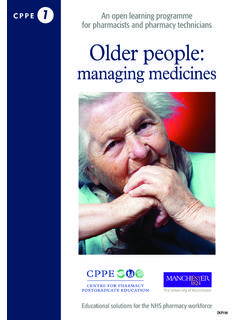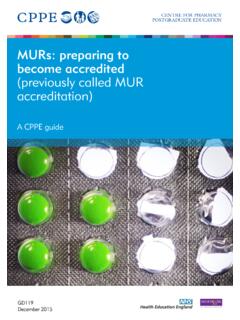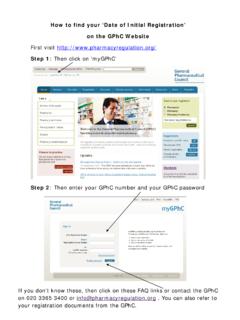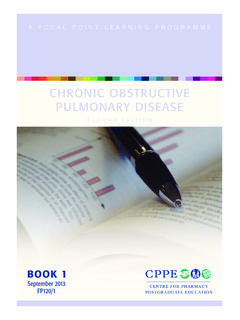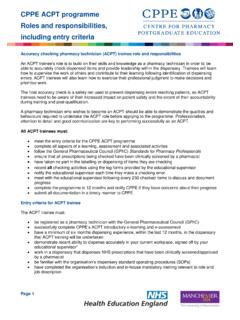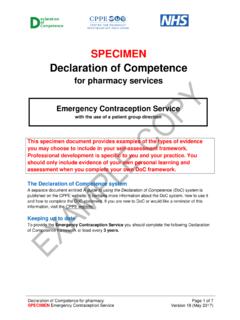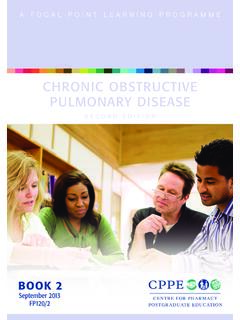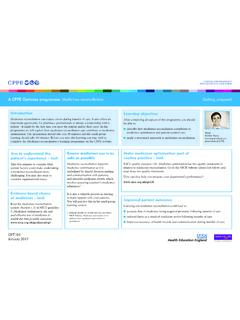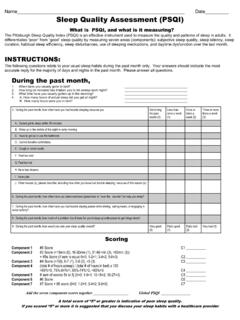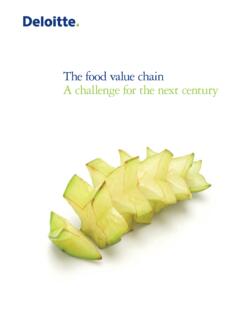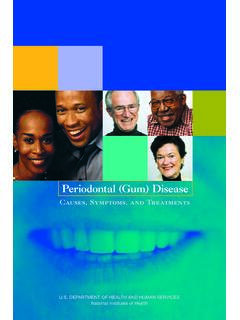Transcription of COMMON CLINICAL CONDITIONS AND MINOR AILMENTS
1 COMMON CLINICAL CONDITIONS AND MINOR AILMENTSCOMMON CLINICAL CONDITIONS AND MINOR AILMENTS1 CONTENTSACKNOWLEDGEMENTS31 ABOUT THIS PACKAGE 42 GASTRO-INTESTINAL SYSTEM Dyspepsia 10 Gastro-oesophageal reflux disease (GORD) 14 Colic 17 Constipation 20 Diarrhoea 25 Irritable bowel syndrome 30 Haemorrhoids (piles) 32 Case studies 35 Suggested responses to gastro-intestinal activities 363 RESPIRATORY SYSTEM Cough 40 Cold 46 Hayfever (seasonal allergic rhinitis) 50 Case studies 53 Suggested responses to respiratory activities 544 CENTRAL NERVOUS SYSTEM Pain relief 58 Teething in children 61 Musculoskeletal pain strains, sprains and bruises 62 Headache and migraine 66 Sleep problems 71 Travel sickness 73 Case studies 74 Suggested responses to central nervous system activities 755 INFECTIONS AND INFESTATIONS Threadworm 78 Head lice 80 Scabies 84 Herpes simplex 87 Shingles 89 Fungal skin infections 92 Athlete s foot 93 Fungal nail infections 96 Ringworm 98 Sweat rash 100 Impetigo 101 Other bacterial skin infections 103 Childhood infections 104 Case studies 105 Suggested responses to infection activities 106 NHS EDUCATION FOR SCOTLAND26 OBSTETRICS.
2 GYNAECOLOGY AND URINARY TRACT INFECTIONS Lower urinary tract infection 110 Vaginal thrush (vulvovaginal candidiasis) 115 Vaginal dryness (atrophic vaginitis) 118 Dysmenorrhoea 120 Case studies 123 Suggested responses to obstetrics, gynaecology and urinary tract infection activities 1247 EYES, EARS AND ORAL HEALTH Conjunctivitis 128 Dry eye 131 Ear care ear wax and ear infections 134 Mouth ulcers (aphthous ulcers) 137 Dry mouth (xerostomia) 141 Oropharyngeal candidiasis 142 Axial cheilitis (angular stomatitis) 144 Sore throat 145 Case studies 148 Suggested responses to eye, ear and oral health activities 1508 SKIN Eczema 152 Contact dermatitis 156 Seborrhoeic scalp CONDITIONS , cradle cap 158 Psoriasis 160 Urticaria 163 Warts and verrucas 165 Nappy rash 168 Acne vulgaris 170 Burns and scalds 172 Sunburn 174 Bites and stings 177 Case studies 182 Suggested responses to skin activities 183 APPENDICES 185 Appendix 1: Resources 186 Appendix 2: Abbreviations 188 Appendix 3.
3 A summary of childhood infections 189 MULTIPLE CHOICE QUESTIONNAIRE 191 COMMON CLINICAL CONDITIONS AND MINOR AILMENTS3 ACKNOWLEDGEMENTSP rincipal author Dr Emily Kennedy, PhD MRPharmSContributing authors Rona Honnet, Principal CLINICAL Pharmacist, Deputy Head of Pharmacy, Wishaw General Hospital Fiona Woodley, Practice Education Co-ordinator (North region), NHS Education for Scotland (NES)Photographs in the skin module kindly supplied by every precaution has been taken in the preparation of these materials, neither NHS Education for Scotland, nor external contributors shall have any liability to any person or entity with respect to liability, loss or damage caused or alleged to be caused directly or indirectly by the information VERSION CONTRIBUTORS:Principal author Dr Emily Kennedy, PhD MRPharmSContributing author Dr John Clyde, General PractitionerProject manager Dr Leon Zlotos, Principal Lead Educational Development - Professional Development, NESE diting and proof reading Val Findlay, Chief Pharmacy Technician, National Co-ordinator for Support Staff Educational Development, NESPaul Gunnion, Independent EditorCommunity pharmacists who piloted the pack.
4 Barbara Luke, Joyce Hayden, Caroline Hannah, Seonaid Campbell and Margaret 2016 NHS EDUCATION FOR SCOTLAND4 ABOUT THIS PACKAGEThis pack looks at COMMON CLINICAL CONDITIONS and MINOR AILMENTS which frequently present in the community MINOR AILMENTS considered in this pack cover a wider range than those which can be treated within these services, but the aim is to encompass the majority of CLINICAL CONDITIONS which may present to the community pharmacist, pharmacy technicians and other support CLINICAL CONDITIONS AND MINOR AILMENTS5 How this package can assist your CPDAt the beginning of each module, the objectives describe what you should be able to do when you complete that particular module. This is designed to help you monitor how you are progressing through the each condition there will be: a brief overview consideration of danger symptoms, including points at which to refer patients CONDITIONS to consider when carrying out a differential diagnosis over-the-counter (OTC) treatment options, with information about evidence base where it is available practical tips, which often encompass non-drug treatment and measures to take to avoid recurrence of the ailment.
5 Special considerations are described for many of the AILMENTS , where extra care and advice is required from the Referral is clarified as either routine or urgent. Urgent referral is normally within six hours of contact and this may require the patient to use the out of hours GP service. The time scale is only a guide and your own professional judgement on the severity of the symptoms and the general health of the patient will be useful to guide referral is used for any condition or symptom that does not require an emergency appointment or response, which often means that the patient can wait to visit their own further information on the direct referral to out of hours services please refer to: EDUCATION FOR SCOTLAND6GP commentA comment from a general practitioner (GP) is also included for many of the CONDITIONS .
6 Communication with our GP colleagues is vital in relation to the community pharmacy contract and established protocols should always be in you see this icon in the text, you are being asked to complete an activity. By undertaking these activities, you will find that the practical tips and learning points from them will prove extremely valuable in your day to day work as they allow you the opportunity to put your learning into practice. You will find suggested responses to most of the activities, unless you are being asked to reflect on your own practice, or to seek out further information on a particular aspect. When you see this box in the text, an exemplar case study is presented to you to read and reflect on. These case studies describe real life scenarios that have been presented to community pharmacists and how the pharmacist responded.
7 Each case study helps to reinforce specific learning points from the text, and gives you an opportunity to reflect on how you would act in a similar you see this icon in the text, this indicates opportunities for developing your role as a pharmacist independent CLINICAL CONDITIONS AND MINOR AILMENTS7 AppendicesAppendices are included at the back of the package, and provide you with further information as follows:Appendix 1 Sources of information used, and useful for further study Appendix 2 Abbreviations used Appendix 3 A summary of childhood infectionsHow to work through the distance learning packEach module takes approximately 1 hour to complete (around 8 hours in total) and is designed to allow you to study the content in bite-sized chunks, so you can plan specific times of study, as well as make use of any spare time which arises.
8 This will also allow you opportunities to put your learning into practice as you work through the course. Since each module covers a discreet topic, you can complete the modules in any order you wish. We would suggest that you work through all the activities and case studies since they will provide you with practical knowledge and skills, as well as relevant points or issues to reflect on during your daily choice questionnaire/assessmentOn completion of the pack, the multiple choice questionnaire (MCQ) should then be attempted and completed via your Portal account at Keeping up to dateThe information is accurate at time of publication but you may wish to keep up to date by checking appropriate resources, many of which are listed in Appendix 1 on p186. You may also wish to obtain the additional references or look up websites listed in small coloured print from time to time throughout the pack for further study, CKS Topic Reviews (PRODIGY Guidance).
9 Pharmacists and pharmacy technicians in Scotland will also be able to keep up to date through websites such as , or EDUCATION FOR SCOTLAND8 NHS EDUCATION FOR SCOTLANDCOMMON CLINICAL CONDITIONS AND MINOR AILMENTS9 GASTRO-INTESTINAL SYSTEM2 OBJECTIVESA fter completing this section you should be able to:Recognise, manage and advise on the symptoms of DYSPEPSIA GASTRO-OESOPHAGEAL REFLUX DISEASE (GORD) COLIC CONSTIPATION IRRITABLE BOWEL SYNDROME DIARRHOEA DYSPEPSIAD yspepsia is a term used to describe a collection of symptoms including upper abdominal discomfort and pain, heartburn, acid reflux (with or without bloating), nausea and vomiting related to eating. It may be caused by non-ulcer dyspepsia (diagnosis made by endoscopy), GORD, peptic ulcer disease (gastric or duodenal) or a hiatus hernia.
10 Differential diagnosesCardiac pain is frequently mistaken for dyspeptic pain and is often difficult to distinguish pain travelling down the arm which is not relieved by antacids is one possible distinguishing symptom and consider accompanying symptoms such as pale/cold/clammy/breathing difficulties. Identify other medicines that are being taken to rule out an adverse effect, eg NSAIDs, iron, bisphosphonates or corticosteroids. Irritable bowel syndrome may also present with similar symptoms, especially accompanied by bloating, although there would usually also be abnormal bowel habits reported. Motility disorders may also be a possibility, which would require referral to the GP. Biliary colic may also present as epigastric pain precipitated by optionsSimple antacids There is limited evidence on the efficacy of antacids in the management of dyspepsia; however, symptomatic relief is often reported with the use of an antacid or alginate.
